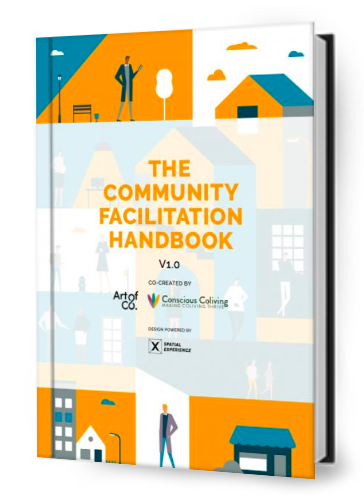In this blog article, adapted from a piece our co-founder Naima previously wrote, we share five reasons why communities fail and six approaches for how to improve community resilience. Also, you will find highlights of the award winning Community Facilitation Handbook. Let’s explore.
In a recent survey of the coliving sector, 66% of respondents reported that their communities were not thriving as much as they would like. “Community” can mean many different things to different people. At Conscious Coliving, we describe it as the coming together of a group where we feel belonging, communicate authentically, and grow together. Explore the Conscious Coliving Manifesto v3.0 here.
The insights are based on years of research and personal experience living in and visiting communities in New Zealand, France, USA, Bangladesh, Costa Rica, Guatemala, Philippines, United Kingdom, Germany, Spain, and Argentina.
5 Reasons Why Communities Fail
1) Mentality of scarcity. Understandably, everyone wants their own needs met. Communities often meet needs through principles of sharing. Some individuals may feel that sharing is an impingement on their space, their time, and resources.
2) Lack of commitment. In our modern society of endless options, people often lack commitment to places and to each other. When a problem arises, there is a tendency to just walk away. Like many modern relationships, people “bounce” when things get difficult, instead of trying to work through it. Communities face the same challenge.
3) All talk, no build. Sometimes, a group of people will become very excited about the idea of creating a community together but it will stay very much in the ideation phase. A lack of organization or planning capacity can leave a community in limbo.
4) Structural Tension. People come from different backgrounds and will have different tastes and preferences. These differences in opinion will certainly extend to how a living space looks, feels, and operates. The design of a community space may not fit the preferences of certain individuals, which can lead to tension among members of a community.
5) Lack of a common purpose or spiritual glue. People can easily come together when the going is easy and fun. Community-building without a deeper root, however, can easily splinter during rough patches.
These are five key reasons why communities fail. Building a thriving community is a very complex endeavor. Nevertheless, there is huge value on co-creating communities that thrive – and it is possible.
Bellow we share 6 approaches to the reasons communities fail.
6 Approaches to Improve Community Resilience
The possibility of our dear community failing can be daunting. That is ok, as we really care. And fear starts dissolving as soon as we take positive and optimistic action. One step at a time. In this Keynote you can explore how to foster thriving communities.
Here you have 6 approaches you can use to improve the resilience of your community:
1) Healthy Communication. At the very core of most successful partner relationships is the capacity for healthy communication. The same is true for community relationships. Communities such as Tui, a New Zealand-based intentional community of 40 adults and children, have their members trained in Nonviolent Communication (NVC), a form of communication which emphasizes deep listening, attentiveness, empathy, and engenders a mutual desire to give from the heart. It aims to replace patterns of judging, defending, demanding, or attacking with focus on clarifying what is being observed, felt and needed.
2) Pre-planning. Investing time in design and deciding on the ethos of a community before it is established can take a lot of preparatory work. But such effort can pay off in the long run. The LifeItself hub in London, for instance, spent several weeks before opening to develop the space design, vision, values, and responsibilities of the community.
3) On-boarding and Living Guidelines. While inclusivity is certainly a common value that many communities ascribe to, setting some parameters or filters upon admitting new members can help align lifestyles and values. Embassy Network, a network of place-based communities experimenting with new forms of governance and solidarity, for instance, has a set of parameters that all members are expected to live by. These include a focus on values, payments, communication, harassment, curation of members, and feedback. If after a trial period a resident is not ascribing to these, that person will be requested to change behavior or leave.
4) Core group. Depending on the size of a community, it may be helpful to have a core group of dedicated individuals who meet regularly to address issues that not the whole community needs to get involved with. Tui for instance has a core group of about seven or eight members who meet bi-weekly to discuss any operational, financial, or other issues that needs resolving.
5) Eat together! New research from University of Oxford has revealed that the more often people eat with others, the more likely they are to feel happy and satisfied with their lives. The dinner table can act as a unifier, a place of community. Sharing a meal is an excuse to catch up and talk, one of the few times where people are happy to put aside their work and take time out of their day. At New Directions, most meals are eaten together, with member taking turns cooking for each other.
6) Common purpose and spiritual backbone. According to a study of millenials, western culture is far too outward focused, glorifying material success at the expense of deeper wellbeing and understanding of self. Spirituality, which as the report Spiritualise describes, “stands for lifestyles and practices that embody a vision of human existence and of how the human spirit is to achieve its full potential,” stresses the importance of attuning to our inner life.
Plum Village, a global community of mindfulness practice centres, for instance, is based on engaged Buddhism. The longstanding Findhorn describes it’s community of over 500 people as a dynamic experiment where “everyday life is guided by the inner voice of spirit, where we work in co-creation with the intelligence of nature and take inspired action towards our vision of a better world.” Tui also has spiritual awareness as one of its essential principles and supports residents to participate in a variety of educational and spiritual practices.
There are certain virtues which have come to be associated with spirituality including compassion, empathy and open-heartedness. As learned through conversation, observation, and experimentation, communities in which members share a common purpose are likely to be far more resilient and harmonious than those without. This common purpose can be a spiritual, but it does not need to be one. Simply coming together to make each-other lives better, to help each-other grow, already is a powerful common purpose. Happily, we see many coliving communities already creating such shared spaces.
Building & Facilitating Communities
Naima and Matt, co-authors of this blog article, have collaborated with Art of Co to make this complex topic simple.
After interviewing over 12 contributors representing coliving communities from Germany, Spain, Israel, Russia, Costa Rica, United Kingdom, USA, France, The Netherlands and Singapore, The Community Facilitation Handbook v1.0 was released.
In 2021, the handbook won “Best Thought Leadership Piece” at the Coliving Awards. You can now download your copy for free here:
Do you live in community? Share your experiences with us! We remain constantly curious about what works and what doesn’t. Finding the differences that make the difference is our collective endeavor.
Would you like support on creating a thriving community? We are coliving researches and consultants and would be happy to explore how can we collaborate. You can learn more about Conscious Coliving and partners here.
This article has been authored for you by:
Transformational Coach and facilitator. Trainer in mindfulness, sharing circles, and how to live and lead more consciously. Co-author of the Community Facilitation Handbook and the Coliving Apps & Tech Guide. Facilitates community engagement strategies.
Matt is responsible for designing community experience and impact strategies and measuring the social value of coliving communities. Matt is also a founding member and current Head of Community of Co-Liv and has worked for The Collective on their Impact Team.

